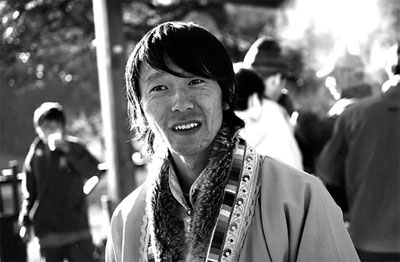Tucked deep in the northwestern mountains of Yunnan Province, the country's first "national park" attracts visitors with its painstakingly detailed environmental preservation plan. The carefully designed "green toilets" provide the biggest surprise to newcomers to Pudacuo National Park, in Shangri-la. Completely powered by solar panels, these clean restrooms feature waterless urinals, take-away bag toilets and smell of cedar rather than emitting the more common public restroom odor.
Shudu Lake, inside Pudacuo National Park, is one of the natural beauties attracting more tourists.
This attention to the slightest environmental impact resulting from infrastructure can be seen at nearly every step. Private cars must be left behind at the park entrance, where visitors board a green-colored bus meeting Euro III emissions standards.
Locally hired and trained tour guides explain the history of the area and the communities within the park as the bus traverses narrow impact-minimizing single-lane roadways tunneling through marshy grasslands and emerald pine forests.
With its diversity of wetlands, Pudacuo is home to a great biodiversity of aquatic and bird species. Walking trails that circle the lakes and traverse wetlands are slightly elevated to permit water-flow and allow light penetration to foster vegetation growth beneath the walkways.
This once-remote, mountainous region of northwest Yunnan Province is undergoing a boom in development and tourism, which are bringing profound changes.
The tourism rush means quick prosperity for many, but if not carefully planned and managed, these changes could seriously impact the area's environment and culture.
This tour guide at Pudacuo National Park is one of many local people who are benefiting from the tourist boom.
The park uses conservation innovations from around China and the rest of the world.
The Nature Conservancy (TNC), an international conservation organization that has been working in Yunnan for almost 10 years, worked with local governments and institutions to introduce the national park concept.
It has been TNC's primary project in Yunnan, and now, after years of preparation, the Diqing Tibetan Autonomous Prefecture government has opened Pudaco National Park to the public.
Also, 13 of the 15 counties in northern Yunnan are also below the Chinese poverty line, with most residents earning annual incomes of less than $85 per capita. While the region is rich in copper and other minerals, and has great hydropower potential, its splendid ecological resources and unique ethnic cultures have made tourism a leading industry.
Mystical images of an unspoiled mountainous "Shangri-la", where spiritual people live in harmony with nature, have long attracted visitors to the region.
In a bold move to further promote tourism and economic growth, the local government officially renamed the city of Zhongdian as Shangri-la in 2002, taking inspiration from the 1933 James Hilton novel Lost Horizon.
The scheme worked to some degree. According to the Shangri-la Tourism Bureau, tourism in the city has surged from an annual 1.2 million visitors and revenue of 280 million yuan ($38 million) in 2001 to more than 1.45 million visitors and revenue of over 530 million ($72 million) in 2005.
But determining exactly how to manage these steadily increasing numbers of visitors in terms of resources, infrastructure and attractions, while also preserving Shangri-la's scenic resources, valuable ecology and unique cultures is a daunting task.
Pudacuo National Park, outside the city of Shangri-la, provides possible solutions by allowing for carefully planned tourism and income-generating activities, while also conserving a large biodiversity priority area.
TNC arranged extensive training and study tours to national parks in the United States and New Zealand for local government officials as well as park planners and staff.
Visiting these national parks not only introduced planners to modern management methods, but also helped them better understand China's unique conditions - foremost in this case, the issue of communities living within the park.
As 127 countries have adopted the national park model, local forestry official and TNC national park advisor He Qiang believes: "It makes sense for China as well, just as long as its adapted to actual conditions in China." But he was surprised by what he found when visiting Yellowstone National Park, which was the world's first national park. "I was somewhat disappointed when visiting Yellowstone, seeing such a large area of land, and other than tourists, no one lives there."
Other planners echo He's feelings, stressing the importance of communities within the park and their roles in co-managing biodiversity conservation.
Befitting China's development objectives, "people as the base" is a reoccurring phrase in discussions of the park. This approach to planning has also been key in earning the enthusiastic support of locals for establishing the park.
Ye Wen, dean and professor of ecotourism at China's Southwest Forestry University and a key figure in planning Pudacuo, stresses that every detail of opening the area for national park development underwent environmental impact assessments. In fact "not one tree was cut in the development of walking trails," he explains.
Officials explain that the park is as much about education as it is conservation. "The idea of eco-tourism is still quite young in China," Ye says. "So giving visitors an educational experience on the importance of preserving nature is one of our main goals."
(China Daily by Steve Black December 3, 2007)





